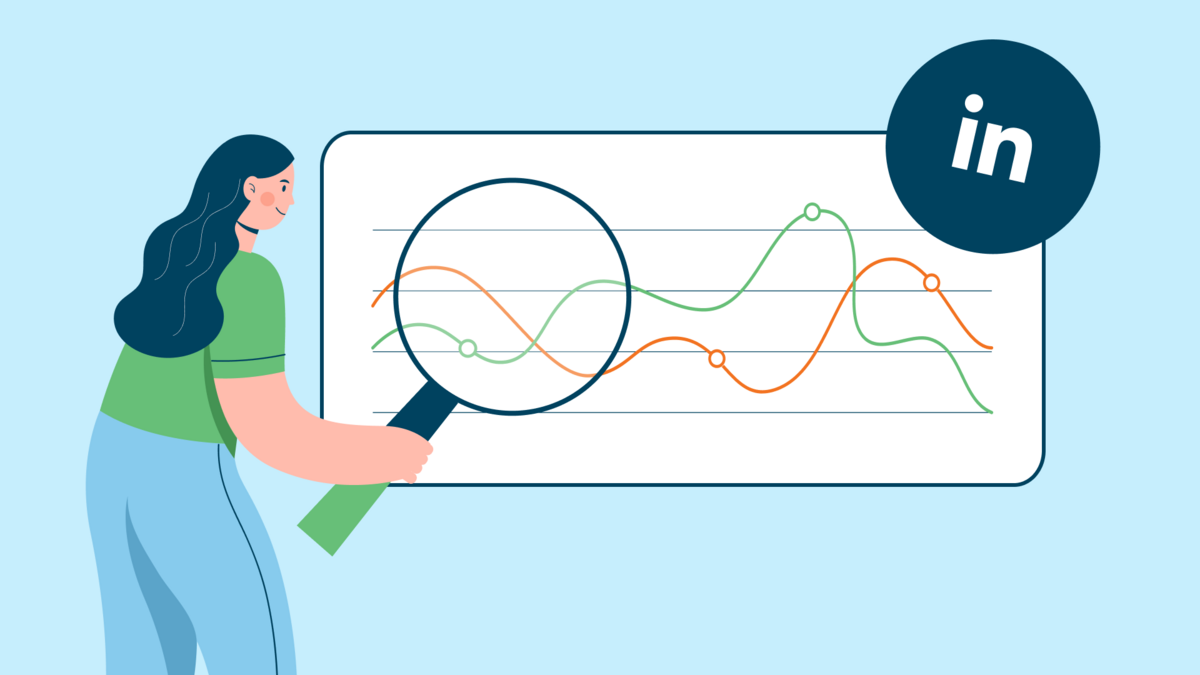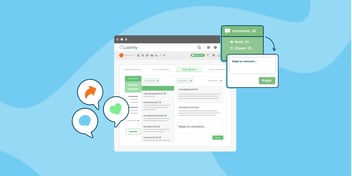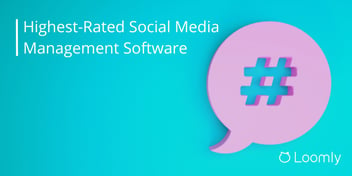Everything You Need To Know About LinkedIn Analytics
With over 900 million users worldwide, LinkedIn has become the largest social media platform for professionals and businesses to expand their networks and promote their brands.
To ensure the success of their LinkedIn profiles, businesses and individuals have to take a closer look at their Linked analytics to ensure their content is reaching and impacting the right audience.
In this article, we discuss what LinkedIn analytics are, how to access your LinkedIn analytics, the 7 key LinkedIn metrics to track in 2023, why you should track your analytics, and the best third-party LinkedIn analytics software available on the market.

Manage all your social media accounts in one place.
Craft, schedule, & auto-post content to all your social channels, then track analytics and manage interactions from a single, easy-to-use dashboard.
What is LinkedIn Analytics?
LinkedIn Analytics are a set of tools that provide users with valuable insights and data into the performance of their LinkedIn presence. With LinkedIn Analytics, users can track the number of views, engagements, and followers they have on their profile, as well as the demographics of their audience. This data can help users understand how their content is resonating with their target audience, and make informed decisions about their social media strategy.
For more information about how you can use LinkedIn to grow your network, check out our comprehensive guide to LinkedIn marketing.
How to access your LinkedIn Analytics: A step-by-step guide
Here’s a step-by-step guide on how to access your LinkedIn analytics, so you can follow along as we delve into key metrics to focus on
- Log in to your LinkedIn account and navigate to your profile.
- Click on the “Me” icon in the top navigation bar. A dropdown menu will appear.
- From the dropdown menu, select “Analytics” and click on it. This will take you to the LinkedIn Analytics page.
- On the LinkedIn Analytics page, you’ll find an overview of your activity, including your recent posts, follower count, and profile views.
- To dive deeper into specific metrics, click on the tabs available, such as “Visitors,” “Updates,” or “Followers.” These tabs provide detailed insights into various aspects of your LinkedIn activity.
- Explore the different sections and metrics available within each tab. For example, under the “Visitors” tab, you can find information on who viewed your profile, where they work, and their job titles.
- To access more in-depth analytics, click on the “See all” or “View more details” buttons, where applicable. This will provide you with a comprehensive view of your LinkedIn performance over a selected period.
- Customize your analytics by adjusting the date range using the dropdown menu located at the top right corner of the page. This allows you to analyze your performance for specific time frames and compare different periods.
- Export data if needed by clicking on the “Export” button, usually located at the top right corner of each analytics section. This enables you to save the data for further analysis or reporting purposes.
By following these simple steps, you can access your LinkedIn analytics and start exploring the various metrics available. Using Loomly, you can track all your analytics from a single place. Loomly also offers content suggestions, and allows you to schedule your posts in advance for LinkedIn and other social media channels.
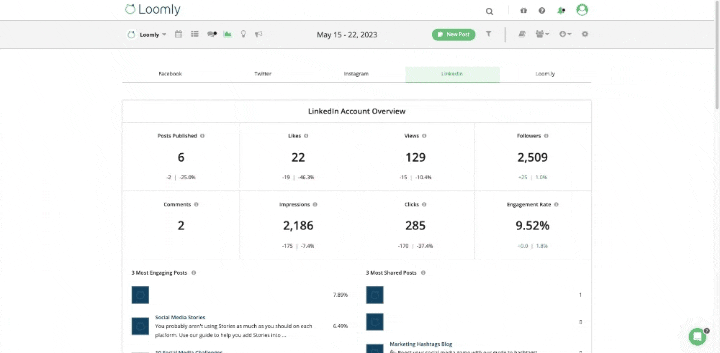
What are the 7 key metrics to focus on with LinkedIn Analytics and why are they important?
Most users of LinkedIn can be classified into 2 categories — businesses and individuals. With over 20 different metrics measured on LinkedIn analytics, it is easy to get lost in a sea of numbers. Here are the top 7 key features that impact your LinkedIn branding and visibility the most, either as an individual content creator or as a business.
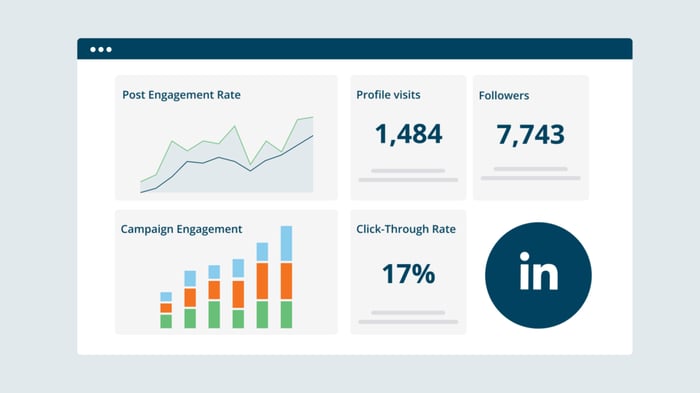
1) Impressions
Impressions refer to the number of times your content, such as posts, updates, or articles, has been displayed on LinkedIn. This metric indicates the reach and exposure of your content. By tracking impressions, you can evaluate the effectiveness of your content strategy and identify opportunities to increase your visibility on the platform.
2) Click-Through Rate (CTR)
CTR measures the percentage of users who click on your content after seeing it. It is a vital metric that gauges the relevance and appeal of different content types to your target audience. A high CTR indicates that your content is compelling and enticing enough to attract clicks. By optimizing your content and headlines, you can increase your CTR and drive more traffic to your LinkedIn profile or website.
3) Engagement rate
Engagement rate gives actionable insight on the level of interaction and involvement your content generates from LinkedIn users; i.e. your content performance. It includes actions such as likes, comments, shares, and clicks. A high engagement rate indicates that your content is resonating with your audience and encourages them to actively participate. Engaging content can help build relationships, establish thought leadership, and expand your network on LinkedIn.
4) Followers
The number of followers represents the size of your LinkedIn audience and the potential reach of your content. It is an essential metric for both businesses and individuals, as it indicates the level of interest and trust your audience has in your brand or personal profile. Growing your follower base can amplify your content’s visibility and increase the likelihood of engagement and conversions.
5) Follower demographics
LinkedIn analytics provides data on follower demographics such as location, industry, job title, and seniority. Analyzing these demographics can help you tailor your content and messaging to better resonate with your audience’s interests and preferences. It enables you to create more targeted and relevant content, leading to higher engagement and stronger connections.
6) Profile visits
Profile visits measure the number of users who view your LinkedIn profile. It indicates the level of interest and curiosity users have in learning more about you or your business. By tracking profile views and visitor analytics, you can gauge the effectiveness of your LinkedIn profile, headline, and summary. A higher number of profile visits suggests that your profile is compelling and encourages users to explore further, leading to networking opportunities or business leads.
7) Conversion tracking
Conversion tracking is crucial for businesses on LinkedIn, as it measures the actions users take after engaging with your content. It can include form submissions, downloads, purchases, or any other desired action. By setting up conversion tracking, you can evaluate the ROI of your LinkedIn ads and determine their effectiveness in generating leads or driving conversions. This metric allows you to optimize your strategies and allocate resources to the most successful campaigns.
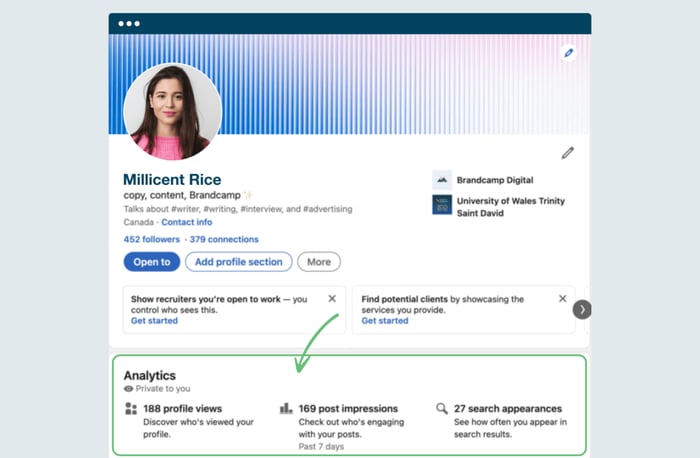
How to make the most of your LinkedIn Analytics
While every LinkedIn user has access to their analytics, what sets great profiles apart is what they do with the data they get. Here are a few key steps to take to ensure that you are getting the most out of your LinkedIn analytics regardless of your company size:
1) Set goals
Setting goals is the first and most crucial step in making the best use of your LinkedIn analytics. Before diving into the data, it’s important to identify what goals you want to achieve on the platform. Are you looking to increase your network, generate leads, or establish yourself as an industry thought leader on the social media platform? By setting clear goals, you can align your analytics efforts with your overall LinkedIn strategy.
Most importantly, ensure that your goals are SMART (Specific, Measurable, Achievable, Relevant and Time-Bound). Focusing on impossible goals like 10k followers in one month, when you’re just starting doesn’t make sense. Focus on your engagement rate and followers will come.
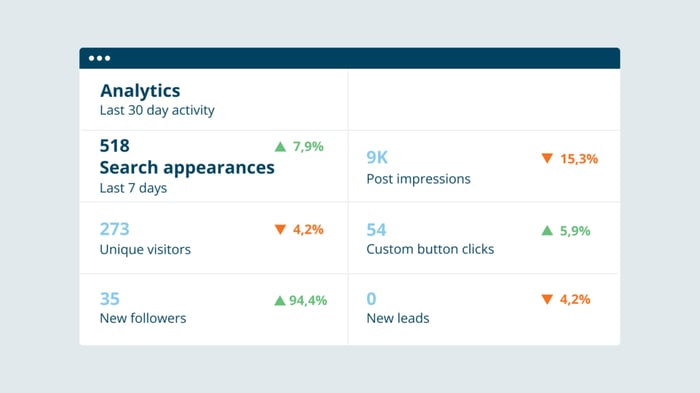
2) Monitor your competitors
LinkedIn analytics allows you to gain insights into your competitors’ performance and engagement levels. By keeping an eye on their activities, you can identify trends, discover new content ideas, and adapt your own strategy accordingly. This competitive intelligence can give you a competitive edge and help you stand out in your industry.
3) Set up conversion tracking
Setting up conversion tracking is crucial for measuring the effectiveness of your LinkedIn campaigns. By implementing conversion tracking, you can track specific actions that users take after engaging with your LinkedIn content, such as filling out a form or making a purchase. This data can provide valuable insights into the ROI of your LinkedIn efforts and help you optimize your campaigns for better results.
4) Use LinkedIn analytics in conjunction with Google analytics
Using LinkedIn analytics in conjunction with Google Analytics can provide a more comprehensive view of your online presence. By integrating the two platforms, you can track and analyze data from both LinkedIn and your website, allowing you to understand the complete user journey. This integration enables you to identify how LinkedIn contributes to your overall website traffic, conversions, and other key metrics.
5) Experiment with different metrics
While we’ve discussed the top metrics to focus on, experimenting with different metrics is essential to understand what works best for your unique LinkedIn goals. Experimenting with different metrics, such as engagement rate, click-through rate, or follower growth, can help you identify the most meaningful metrics for your specific objectives.
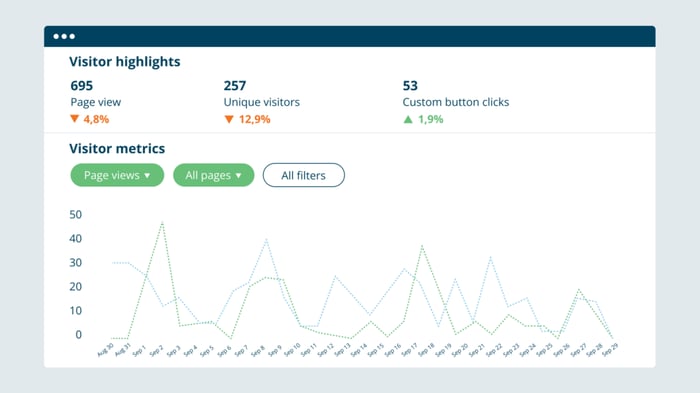
6) Track referral traffic
Tracking referral traffic is another valuable aspect of LinkedIn analytics. By monitoring the sources of your website traffic, you can identify which LinkedIn activities or content are driving the most visitors to your website. This information can help you optimize your content strategy and focus on the types of content that resonate with your LinkedIn audience.
7) Use audience demographic data to influence messaging
LinkedIn analytics provides insights into the demographics of your audience, such as industry, job title, location, and seniority. By understanding your target audience’s characteristics, you can tailor your content and messaging to resonate with their needs and preferences, increasing the chances of engagement and conversions.
Top 5 third-party LinkedIn Analytics tools
While LinkedIn offers a lot of useful data, there are also several third-party tools that offer even more insights to improve your LinkedIn performance.
1) Loomly
Loomly is a comprehensive social media management tool that includes LinkedIn analytics among its features. Trusted by over 21,000 marketing teams around the world including Porsche, LMVH, L’Oreal and BMW, Loomly offers detailed metrics such as post performance, engagement rates, follower growth, and audience demographics. Loomly’s intuitive interface allows you to track and analyze your LinkedIn performance effectively. It also provides content suggestions and scheduling capabilities to streamline your social media workflow.
They offer a 15-day free trial with no credit card required.
2) Databox
Databox is a powerful business and social media analytics tool that integrates with various data sources, including LinkedIn. It enables you to create customized dashboards and analytics reports to track your LinkedIn metrics alongside other key performance indicators. Databox offers pre-built LinkedIn templates, allowing you to monitor engagement, reach, conversions, and more. With its data visualization capabilities, you can easily analyze trends and make data-driven decisions.
3) Hootsuite
Known for its social media management capabilities, Hootsuite offers comprehensive reporting on your LinkedIn activities, including post performance, follower growth, and engagement metrics. Hootsuite’s analytics feature allows you to measure the impact of your LinkedIn campaigns and optimize your strategy accordingly. Additionally, Hootsuite enables you to schedule posts, engage with your audience, and monitor social media conversations.
4) Looker Studio (Formerly known as Google Data Studio)
Google Data Studio is a free and versatile data visualization tool that can integrate with various data sources, including LinkedIn. It allows you to create interactive dashboards and reports, providing a visual representation of your LinkedIn analytics. With its drag-and-drop interface, you can easily customize your reports and gain insights into your LinkedIn performance. Google Data Studio offers advanced data filtering, date range comparisons, and collaboration features.
5) Brand24
While primarily known for social media monitoring and reputation management, Brand24 also offers LinkedIn analytics capabilities. It provides insights into your LinkedIn mentions, engagement levels, sentiment analysis, and competitor benchmarking. Brand24’s real-time monitoring allows you to track conversations and identify opportunities for engagement and lead generation on LinkedIn. The tool also offers sentiment analysis, enabling you to gauge the overall sentiment associated with your brand on the platform.
Wrapping up
With LinkedIn analytics, there’s no guesswork. It allows you to accurately measure the quality of your content and how well it resonates with your audience. But, to get the most out of LinkedIn analytics, it’s important to set clear goals, regularly track your metrics, and make adjustments as needed to optimize your content and engagement.
Loomly offers several tools to help you optimize and automate your LinkedIn journey. Start your 15-day free trial today!
